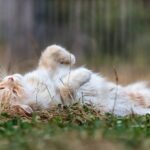Have you ever wondered if your cat feels something more than just a need for food or a warm lap? The truth is, cats are far more emotionally complex than many people believe. Behind those mesmerizing eyes and mysterious purrs, our feline friends are capable of forming deep bonds. Some of their signs of affection are subtle, almost like a secret language. Learning to recognize when your cat has grown emotionally attached can be both surprising and heartwarming—sometimes, they show love in ways you’d never expect. If you’re ready to discover the hidden signs that your cat truly cares, let’s unravel the emotional world of your whiskered companion.
Seeking Out Your Company

One of the most heartwarming signs that a cat has become emotionally attached is the way they seek out your presence. If your cat consistently chooses to be in the same room as you, even when there’s nothing exciting happening, it’s a clear indication of their fondness. They might follow you from room to room, curl up on your lap, or simply lounge nearby. This behavior goes far beyond a simple desire for warmth or food—it’s a sign that your cat feels safe and content around you. Cats are naturally independent creatures, so when they choose to share their space with you, it speaks volumes. Notice how your cat reacts when you come home; some may greet you at the door or vocalize, showing genuine excitement. This desire to be near you is a powerful sign of emotional attachment.
Slow Blinking and Eye Contact

Have you ever caught your cat giving you a long, slow blink? This gentle gesture is often called a “cat kiss,” and it’s one of the most intimate ways felines communicate trust and affection. When a cat slowly blinks at you, it’s a sign they feel relaxed and safe in your presence. You can even try returning the gesture to strengthen your bond. Direct eye contact, when accompanied by soft blinks, signals that your cat is comfortable and emotionally connected. Unlike a hard stare, which can be intimidating, slow blinking is a peaceful exchange. This kind of silent communication may seem subtle, but in the world of cats, it’s a big deal. If your cat often gazes at you with soft eyes, they’re showing genuine affection.
Bringing “Gifts” and Sharing Toys

It might be shocking—or even hilarious—when your cat drops a toy (or sometimes something less pleasant) at your feet. While it may seem odd to us, this behavior is rooted in your cat’s natural instincts and is a sign of emotional attachment. By sharing toys or “gifts,” your cat is showing they trust you enough to share their prized possessions. In the wild, cats bring prey to those they care for, and this behavior translates into domestic life with toys or other found objects. If your cat regularly places items near you or in your bed, it means they see you as part of their family. It’s their unique way of saying, “I care about you.” Next time you find a favorite toy on your pillow, consider it a feline love letter.
Purring and Physical Affection

The soothing sound of a cat’s purr is more than just a sign of contentment—it can also signal a deep bond. Cats purr for many reasons, but when they do so in your presence, especially while being petted or cuddled, it’s a strong indicator of emotional attachment. Alongside purring, cats may rub their heads or bodies against you, a behavior known as “bunting.” This act marks you with their scent, essentially claiming you as their own. Some cats will even knead your lap with their paws, a comforting action they associate with kittenhood. These displays of affection are clear messages that your cat feels secure and connected to you. If your cat chooses your lap over any other spot in the house, consider yourself truly loved.
Vocalizations and Communication

Cats have an impressive range of vocalizations, and many develop special ways of communicating with their favorite humans. If your cat meows, chirps, or trills at you more than others, it’s likely a sign of emotional closeness. Some cats even develop unique “conversations” with their owners, responding to your voice with their own. These vocal interactions are not just demands for food or attention—they’re a way for your cat to connect and express their feelings. Pay attention to the tone and frequency of your cat’s sounds; happy, contented meows are often reserved for those they trust most. Communication is a two-way street, and a cat who talks to you is a cat who values your relationship.
Following Your Routine and Mirroring Behaviors

A cat that is emotionally attached will often align their daily routine with yours. You might notice your cat waking up when you do, accompanying you during your morning routine, or even waiting outside the bathroom door. This behavior is a sign that your cat is attentive to your habits and enjoys being part of your day-to-day life. Some cats will even mirror your actions, such as stretching when you do or lying down when you relax. This synchronization is a form of social bonding, much like friends or family members who fall into step with each other. If your cat seems to anticipate your movements or prefers to spend time with you during your activities, it’s a clear indication of their emotional attachment.
Displaying Vulnerability and Trust

Perhaps the most touching sign of emotional attachment is when a cat allows themselves to be vulnerable around you. If your cat exposes their belly, sleeps deeply in your presence, or lets you touch sensitive areas like their paws or face, it shows a profound level of trust. Cats instinctively protect themselves, so letting their guard down is a major gesture. You might find your cat sleeping next to you or even on you, demonstrating that they feel completely safe. This openness is reserved for those they consider family. When a cat chooses to relax fully around you, it’s a silent declaration of love and loyalty—a rare gift that should never be taken for granted.

Linnea is a born and bred Swede but spends as much time as possible in Cape Town, South Africa. This is mainly due to Cape Town’s extraordinary scenery, wildlife, and atmosphere (in other words, because Cape Town is heaven on earth.) That being said, Sweden’s majestic forests forever hold a special place in her heart. Linnea spends as much time as she can close to the ocean collecting sea shells or in the park admiring puppies.






